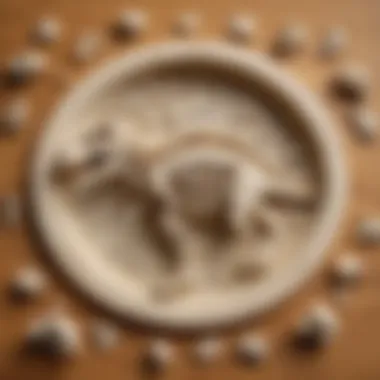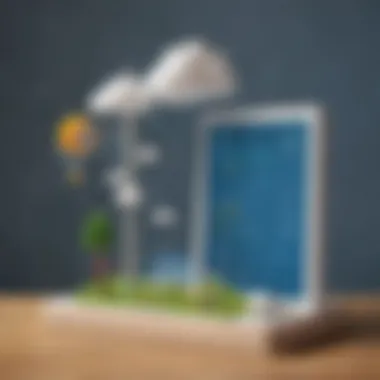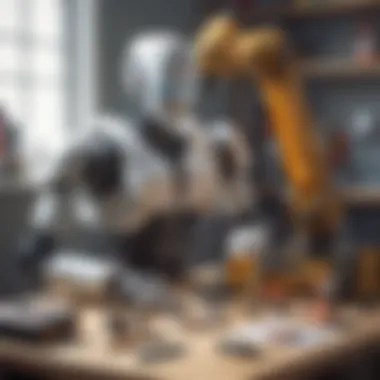Innovative 3D Printing Ideas to Inspire Young Science Enthusiasts


Science Fun Facts
Diving into the world of 3D printing can unlock a treasure trove of intriguing scientific trivia and facts for young minds to explore. Did you know that the concept of 3D printing, also known as additive manufacturing, dates back to the 1980s? It's a technology that allows objects to be created layer by layer from digital designs. Additionally, 3D printing has been used to create everything from prosthetic limbs to skyscraper models, showcasing its diverse applications in various fields.
Discover the Wonders of Science
Embark on a journey to discover the wonders of science through 3D printing. By delving into various scientific concepts such as physics, engineering, and design, children can unravel the mysteries of how 3D printers work and the science behind turning digital models into tangible objects. Explore educational videos and animations that showcase the endless possibilities of 3D printing, from building intricate structures to replicating ancient artifacts. Engage with interactive learning tools that simulate the 3D printing process, allowing young enthusiasts to grasp the intricate details of this innovative technology. Discover the real-life applications of science through 3D printing by unveiling how this cutting-edge technology is revolutionizing industries like healthcare, architecture, and aerospace.
Science Experiment Showcase
Step into the world of hands-on exploration with a science experiment showcase that integrates 3D printing into interactive and engaging experiments. Dive into fun and educational experiments that demonstrate the principles of physics, chemistry, and material science through innovative 3D-printed models and tools. From building a mini catapult using 3D-printed components to experimenting with buoyancy using custom-designed objects, children can enjoy a blend of creativity and scientific inquiry. Follow step-by-step instructions that outline the detailed process of setting up each experiment, from preparing materials to executing the tests. Stay safe during your scientific adventures with essential safety tips and precautions to ensure a secure and enjoyable learning experience.
Introduction
In the realm of innovative and captivating endeavors for young science enthusiasts, delving into the world of 3D printing unveils a plethora of enriching possibilities. This introductory segment serves as a gateway into an exploration of novel ideas tailored for children aged 6-12, aiming to stimulate their scientific curiosity and foster a deep-seated passion for knowledge acquisition. By weaving together educational significance with engaging projects, this article endeavors to illuminate the path towards a dynamic learning experience filled with creativity and practical applications.
Understanding 3D Printing
History of 3D Printing
Unraveling the historical tapestry of 3D printing unveils an intriguing evolution from its nascent stages to its contemporary significance. The origins of this technology date back to the 1980s, marked by significant advancements that revolutionized manufacturing processes worldwide. Understanding the historical backdrop of 3D printing sets the stage for comprehending its transformative potential in various fields, including education and innovation. The distinctive feature of historical insights lies in their ability to offer a roadmap of progress and inspire future advancements while equipping young minds with a contextual understanding of this groundbreaking technology.
Basic Concepts
Navigating through the foundational principles of 3D printing introduces budding scientists to a spectrum of essential concepts underpinning this cutting-edge technology. From additive manufacturing approaches to material extrusion techniques, grasping the basic tenets of 3D printing lays a solid groundwork for venturing into intricate projects and designs. The intrinsic appeal of basic concepts lies in their role as building blocks for creative exploration, empowering young learners to experiment, iterate, and refine their skills in the realm of three-dimensional fabrication.
Importance in Education
Recognizing the pivotal role of 3D printing in education illuminates its vast potential as a transformative tool for enriching classroom experiences. Integrating 3D printing into educational settings fosters hands-on learning opportunities, aligning with contemporary pedagogical trends that emphasize experiential and practical learning. The significance of incorporating 3D printing in education lies in its capacity to nurture technical skills, promote innovation, and cultivate a deep-seated appreciation for STEM disciplines among young learners.
Benefits of 3D Printing for Children


Hands-On Learning Experience
Embarking on a journey of hands-on learning through 3D printing equips young enthusiasts with tangible tools to interact with complex concepts in a tactile manner. By engaging in the physical creation of three-dimensional models, children gain a deeper understanding of abstract ideas, fostering a holistic approach to learning that transcends traditional classroom boundaries. The hands-on learning experience not only enhances retention and comprehension but also instills a sense of pride and accomplishment in young minds.
Enhanced Creativity
Exploring the realms of creative expression through 3D printing unlocks boundless opportunities for children to unleash their imaginative prowess. From conceptualizing unique designs to bringing them to life through digital sculpting and printing, the process nurtures a child's innate creativity and ingenuity. The enhanced creativity stemming from 3D printing projects transcends mere aesthetics, fostering a mindset of innovation and originality that paves the way for future exploration and discovery.
Problem-Solving Skills Development
Engaging in 3D printing projects nurtures the development of critical problem-solving skills essential for navigating the complexities of the modern world. Tackling design challenges, troubleshooting technical issues, and honing attention to detail in the realm of three-dimensional fabrication cultivates a resilient problem-solving mindset in young learners. The skills developed through 3D printing projects extend beyond the digital realm, empowering children to approach real-world problems with confidence and analytical acumen.
Safety Considerations for Young Users
Non-Toxic Materials
Prioritizing the use of non-toxic materials in 3D printing endeavors ensures the well-being and health of young users, emphasizing safety as a paramount concern in educational settings.
Supervision and Guidance
Offering adequate supervision and guidance during 3D printing activities ensures that children engage with the technology responsibly and autonomously, fostering a safe and conducive learning environment.
Maintenance and Handling
Instilling practices for the proper maintenance and handling of 3D printing tools and equipment cultivates a sense of responsibility and attentiveness in young users, promoting a culture of care and longevity in educational settings.
Educational 3D Printing Ideas
Educational 3D Printing Ideas play a pivotal role in this exploration of innovative 3D printing concepts for young science enthusiasts. By focusing on creating engaging and informative tools that cater to the curiosity of children aged 6-12, this section aims to foster a love for learning through hands-on experiences. Through educational 3D printing, children can delve into subjects like the Solar System, Human Anatomy, and Historical Landmarks, enhancing their understanding and appreciation for these topics.
Creating 3D Printed Models
Solar System


In the realm of educational 3D printing, the Solar System holds a prominent position due to its ability to captivate young minds with its vastness and celestial beauty. By creating 3D models of planets, moons, and asteroids, children can visualize the spatial relationships within our cosmic neighborhood. This not only facilitates a deeper comprehension of astronomy but also instills a sense of wonder and curiosity about the universe. The Solar System models provide a hands-on method of learning that can enhance spatial awareness and astronomical knowledge in a tangible and interactive way.
Human Anatomy
The realm of Human Anatomy in 3D printing opens doors to a fascinating journey inside the human body. By replicating organs, skeletons, and anatomical structures in 3D form, children can explore the intricacies of the human form with unprecedented detail. This immersive experience can aid in understanding biology and physiology in a tactile manner, fostering an early interest in medical sciences. However, it is essential to provide age-appropriate anatomical models to ensure that children grasp anatomical concepts accurately while respecting sensitivities surrounding body portrayal.
Historical Landmarks
In the scope of educational 3D printing, Historical Landmarks offer a bridge between the past and present, allowing young learners to engage with heritage sites and architectural wonders. By producing scaled models of iconic structures such as the Pyramids of Giza or the Taj Mahal, children can appreciate the craftsmanship and historical significance of these edifices. This hands-on approach not only cultivates an understanding of history and culture but also encourages creativity and attention to detail. Additionally, exploring Historical Landmarks through 3D printing promotes spatial reasoning and historical awareness among children.
Building Geometric Puzzles
Tangram Shapes
Tangram Shapes are an integral aspect of educational 3D printing, offering a platform for children to explore geometric principles through interactive puzzles. By assembling various shapes to form intricate designs, youngsters can enhance their spatial reasoning and geometrical understanding. Tangram puzzles stimulate critical thinking and problem-solving skills while fostering creativity and strategic planning. This tactile approach to geometry encourages experimentation and exploration, making learning engaging and enjoyable for young enthusiasts.
Pythagorean Theorem Demonstrations
The Pythagorean Theorem Demonstrations in 3D printing provide a tangible representation of this fundamental mathematical concept. By constructing three-dimensional models illustrating the theorem's principles, children can visually grasp the relationship between the lengths of the sides of a right-angled triangle. This visual aid not only simplifies abstract mathematical ideas but also reinforces the practical applications of geometry in everyday scenarios. Engaging with Pythagorean Theorem Demonstrations through 3D prints promotes hands-on learning and deepens comprehension of geometric theory among young learners.
Archimedean Solids
Exploring Archimedean Solids through educational 3D printing introduces children to the world of three-dimensional geometry and polyhedra. By creating models of Archimedean Solids such as the truncated icosahedron or cuboctahedron, youngsters can appreciate the symmetry and complexity of these unique shapes. Engaging with Archimedean Solids fosters spatial visualization skills and geometric awareness, encouraging children to explore the mathematical beauty inherent in these solid figures. Through hands-on interaction with Archimedean Solids, young science enthusiasts can develop a deeper understanding of geometric concepts in a fun and interactive manner.
Designing Educational Tools
Customized Rulers
Customized Rulers in the realm of 3D printing serve as personalized tools for enhancing measurement skills and geometric understanding among young learners. By incorporating tailored scales, shapes, and designs into rulers, children can engage with mathematical concepts in a creative and practical manner. Customized Rulers not only facilitate accurate measurements but also encourage mathematical exploration and experimentation. The customization aspect enables children to express their creativity while learning fundamental mathematical principles, making the educational experience both personalized and enjoyable.
Mathematical Manipulatives


Mathematical Manipulatives in 3D printing offer interactive resources for children to explore mathematical concepts through hands-on activities. By designing manipulatives that represent numbers, shapes, and operations, youngsters can engage with abstract mathematical ideas in a concrete and visual way. These manipulatives enhance understanding of mathematical concepts such as addition, subtraction, multiplication, and division by providing physical representations that aid in conceptualization. Utilizing Mathematical Manipulatives fosters numeracy skills, problem-solving abilities, and mathematical fluency among young learners, making complex mathematical concepts accessible and engaging.
Interactive Maps
Interactive Maps in educational 3D printing present a dynamic approach to geographical learning and spatial awareness. By creating tactile maps that incorporate topographical features, landmarks, and geographical regions, children can explore the world in a multisensory way. Interactive Maps offer an immersive experience that enhances geographical knowledge, fosters curiosity about different cultures and environments, and promotes spatial thinking skills. Through interactive exploration of maps, young learners can develop a deeper understanding of geography, navigation, and global connections, enriching their learning experience and expanding their worldview.
Fun and Creative 3D Printing Projects
In discussing the 'Fun and Creative 3D Printing Projects' section, it is essential to highlight its significance within this article catering to young science enthusiasts. These projects serve as innovative hands-on activities that engage children aged 6-12, fostering creativity, critical thinking, and problem-solving skills. By incorporating fun elements into 3D printing, children are not only entertained but also exposed to practical applications of technology in a way that stimulates their curiosity and learning.
Personalized Keychains and Decors
Initial Keychains
Exploring the realm of 'Initial Keychains' is a key aspect of this article's focus on personalization and creativity. These keychains offer children the opportunity to customize items with their initials, adding a personal touch to their belongings. Initial keychains are popular among young users due to their simplicity yet meaningful nature. The unique feature of Initial Keychains lies in their ability to reflect individuality and ownership. While they provide a sense of identity and ownership for children, it's essential to consider potential choking hazards for very young users, requiring supervision during crafting and usage.
Favorite Animal Figurines
Diving into 'Favorite Animal Figurines' adds a delightful dimension to this article, offering children the chance to bring their beloved animals to life in 3D form. These figurines capture the essence of children's interests and can serve as both play items and display pieces. The appeal of Favorite Animal Figurines stems from their ability to enhance imaginative play and storytelling while fostering a connection to the natural world. However, careful attention must be paid to intricate details and fragile parts when printing and handling these figurines to prevent breakage and ensure safety.
Room Decorations
Exploring the realm of 'Room Decorations' introduces a practical and artistic angle to the 3D printing projects featured in this article. Room Decorations enable children to personalize their living spaces with unique and functional designs, promoting a sense of ownership and creativity. The key characteristic of Room Decorations is their dual role as decorative items and practical accessories, enhancing the aesthetic appeal of a room while serving a functional purpose. However, it's essential to consider the size and weight of these decorations to prevent potential hazards or accidents in a child's living space.
Conclusion
Encouraging Innovation and Exploration
Nurturing Curiosity:
Delving into the concept of nurturing curiosity within the realm of 3D printing, we uncover a fundamental element that drives the learning process for young minds. Curiosity acts as a catalyst for exploration and inquiry, prompting children to seek answers, engage with new ideas, and push the boundaries of their knowledge. By fostering a sense of wonder and inquisitiveness, educators and caregivers can ignite a spark in children that propels them towards deeper intellectual pursuits and lifelong learning. Encouraging curiosity in 3D printing projects not only leads to skill development but also instills a growth mindset and a passion for discovery.
Inspiring Future Engineers and Designers:
In striving to inspire future engineers and designers through 3D printing endeavors, we unlock a realm of possibilities for young learners to express their ingenuity and problem-solving capabilities. By engaging with design processes, prototyping, and iterative thinking, children are exposed to the foundational principles of engineering and design thinking. This exposure not only cultivates a sense of innovation and creativity but also equips them with essential skills that are highly valued in today's technology-driven world. Inspiring children to explore the intersection of technology and creativity sets the stage for them to become trailblazers in the field of STEM.
Embracing Technology in Education:
Embracing technology in education by incorporating 3D printing opens up a world of experiential learning opportunities that cater to diverse learning styles and aptitudes. By leveraging cutting-edge technology tools, educators can create immersive educational experiences that transcend traditional classroom boundaries and empower students to become active participants in their learning journey. 3D printing in education not only enhances visual-spatial understanding but also fosters collaboration, problem-solving, and adaptability - key skills that are essential for the future workforce. By embracing technological advancements in education, we prepare young learners to meet the challenges of an increasingly digital world and fashion a generation of tech-savvy innovators and problem solvers.







